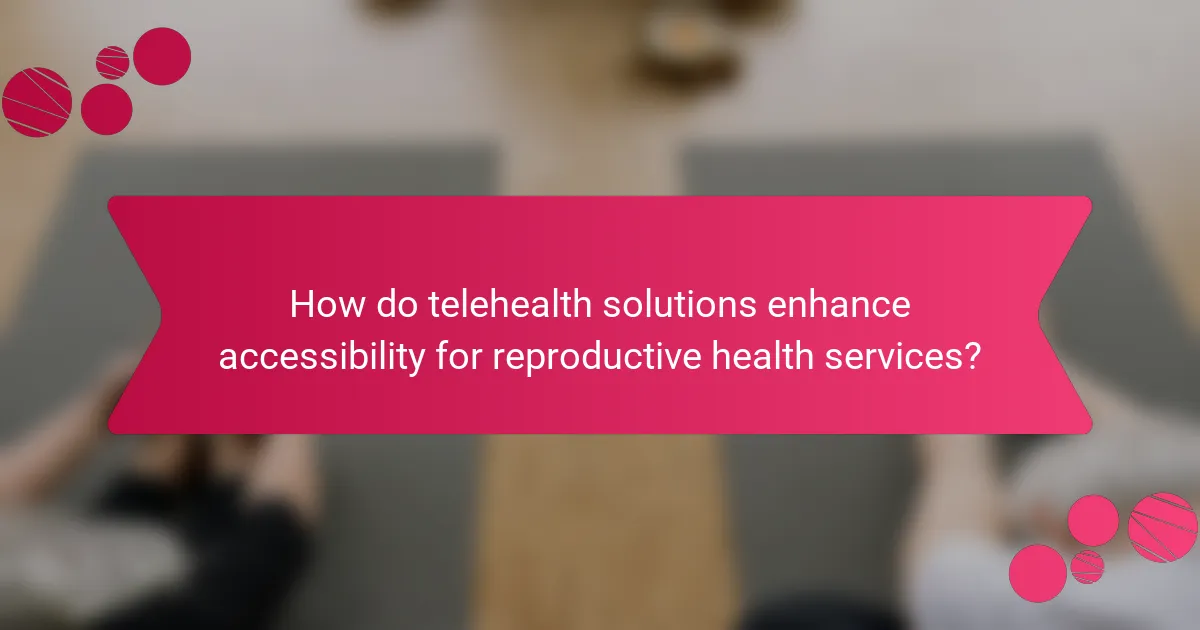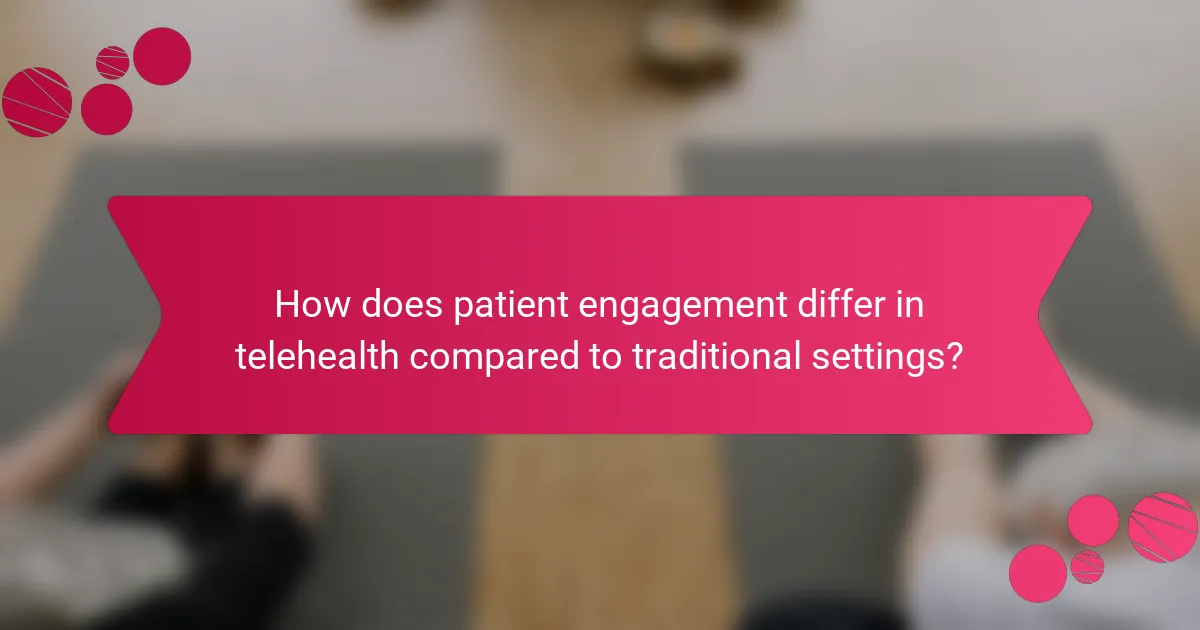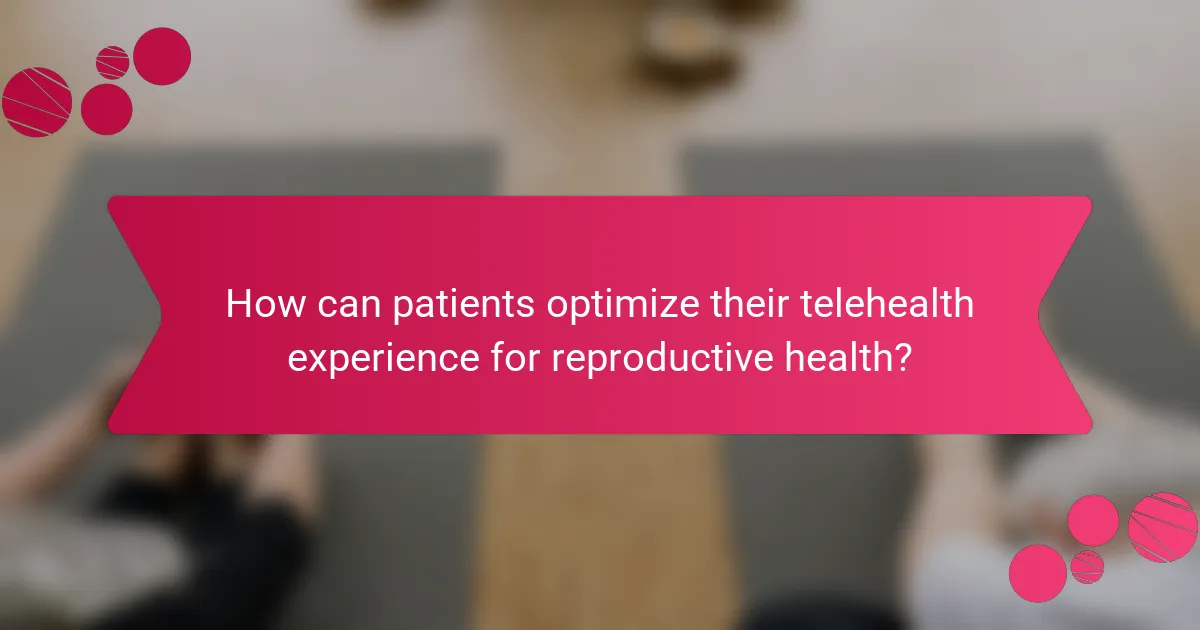Telehealth solutions for reproductive health enhance accessibility and convenience, allowing patients to connect with healthcare providers remotely. These platforms improve patient engagement through personalized care plans and continuous monitoring. They address challenges like technology access and privacy concerns while offering unique benefits such as real-time data analytics. Overall, telehealth fosters a more efficient approach to managing reproductive health needs.

How do telehealth solutions enhance accessibility for reproductive health services?
Telehealth solutions significantly enhance accessibility for reproductive health services by removing geographical barriers and providing convenient care options. Patients can consult healthcare providers from the comfort of their homes, reducing travel time and associated costs. This approach is particularly beneficial for individuals in rural or underserved areas, where access to specialized reproductive health services may be limited. Additionally, telehealth platforms often offer flexible scheduling, allowing patients to receive care at times that suit their needs. As a result, these solutions promote greater patient engagement and adherence to care plans, ultimately improving health outcomes in reproductive health.
What barriers to access do telehealth solutions address?
Telehealth solutions address barriers to access in reproductive health by providing remote consultations, reducing travel needs, and increasing privacy. Patients benefit from enhanced convenience and flexibility in scheduling appointments. Additionally, telehealth can improve access for underserved populations, minimizing disparities in care. This approach also allows for continuous patient engagement through digital tools, fostering better health outcomes.
Which populations benefit most from telehealth in reproductive health?
Populations that benefit most from telehealth in reproductive health include those in rural areas, low-income communities, and individuals with mobility challenges. Telehealth improves access to care, reduces barriers, and enhances patient engagement. For instance, rural populations often face long travel distances to healthcare providers, making telehealth a vital solution. Low-income individuals may lack transportation options, and telehealth provides a more affordable alternative. Additionally, those with mobility issues can receive care from home, ensuring they access necessary reproductive health services.
How do regional regulations impact telehealth accessibility?
Regional regulations significantly influence telehealth accessibility by establishing guidelines that determine service delivery. These regulations impact reimbursement policies, licensing requirements, and the scope of practice for healthcare providers. For instance, some regions allow cross-state telehealth services, while others impose restrictions, affecting patient access. As a result, disparities in telehealth availability can arise, particularly in rural areas where healthcare resources are limited. Understanding these regulations is crucial for enhancing telehealth solutions in reproductive health, ensuring that all patients have equitable access to necessary services.

What are the primary benefits of using telehealth for reproductive health?
Telehealth offers significant benefits for reproductive health, enhancing accessibility, convenience, and patient engagement. Patients can access timely care without geographical constraints, improving overall health outcomes.
1. Increased Accessibility: Patients can connect with healthcare providers from remote locations, reducing travel barriers.
2. Convenience: Telehealth appointments save time, allowing patients to schedule visits around their daily responsibilities.
3. Enhanced Privacy: Patients may feel more comfortable discussing sensitive reproductive health issues in a virtual setting.
4. Continuous Monitoring: Telehealth facilitates regular check-ins, enabling proactive management of reproductive health conditions.
5. Improved Patient Engagement: Digital platforms encourage patients to take an active role in their health management.
These benefits contribute to a more efficient and patient-centered approach to reproductive health care.
How does telehealth improve patient outcomes in reproductive health?
Telehealth significantly improves patient outcomes in reproductive health by enhancing accessibility, increasing engagement, and providing timely care. Patients can access specialists without geographical constraints, leading to improved satisfaction and adherence to treatment plans.
Telehealth solutions enable remote monitoring and consultations, allowing for personalized care tailored to individual needs. Studies show that telehealth can reduce wait times and increase the frequency of follow-ups, which is crucial for reproductive health management.
Moreover, telehealth fosters better communication between patients and healthcare providers, encouraging patients to discuss sensitive issues more openly. This increased transparency can lead to more accurate diagnoses and effective treatment strategies.
In summary, telehealth enhances reproductive health outcomes by improving access to care, fostering patient engagement, and facilitating timely medical interventions.
What cost savings can patients expect from telehealth services?
Patients can expect significant cost savings from telehealth services, often reducing expenses by 30-50%. Telehealth minimizes travel costs and time off work while providing affordable access to specialists. This service often leads to lower overall healthcare spending by preventing unnecessary emergency room visits. Additionally, many telehealth platforms offer transparent pricing, enhancing financial predictability for patients.
Which telehealth technologies are most effective for reproductive health?
Telehealth technologies for reproductive health include video consultations, mobile health apps, remote monitoring devices, and teletherapy platforms. These solutions enhance accessibility, improve patient engagement, and offer personalized care.
Video consultations allow real-time interaction with healthcare providers, facilitating timely advice and support. Mobile health apps provide resources for tracking menstrual cycles, fertility, and pregnancy, empowering patients with information. Remote monitoring devices enable ongoing health assessments, ensuring proactive care. Teletherapy platforms offer mental health support, addressing emotional aspects of reproductive health.
These technologies collectively enhance patient access to reproductive health services, leading to improved health outcomes. Studies indicate that telehealth can increase patient satisfaction and adherence to treatment plans.

How does patient engagement differ in telehealth compared to traditional settings?
Patient engagement in telehealth differs from traditional settings by offering enhanced accessibility and convenience. Telehealth allows patients to interact with healthcare providers remotely, reducing travel barriers and wait times.
In traditional settings, engagement often relies on in-person visits, which can limit participation due to geographical and scheduling constraints. Telehealth fosters continuous communication through digital platforms, enabling timely follow-ups and ongoing support.
Additionally, telehealth can provide personalized resources and educational materials tailored to individual needs, enhancing patient understanding and involvement in their reproductive health. This shift leads to increased satisfaction and adherence to treatment plans, highlighting telehealth’s unique attribute of adaptability in patient engagement.
What strategies enhance patient engagement in telehealth for reproductive health?
Effective strategies to enhance patient engagement in telehealth for reproductive health include personalized communication, user-friendly technology, and proactive follow-ups. Personalized communication fosters trust and encourages patients to share concerns. User-friendly technology ensures accessibility and ease of use, reducing barriers to participation. Proactive follow-ups, such as reminders for appointments and check-ins, keep patients informed and engaged in their care. By integrating these strategies, healthcare providers can significantly improve patient interaction and satisfaction in telehealth settings.
How can healthcare providers measure patient satisfaction in telehealth?
Healthcare providers can measure patient satisfaction in telehealth through surveys, feedback forms, and patient interviews. These tools assess aspects like accessibility, communication quality, and overall experience. Regular evaluation of these metrics enhances service delivery and patient engagement. Additionally, analyzing patient retention rates provides insights into satisfaction levels, helping providers tailor their telehealth solutions effectively.
What role does education play in patient engagement with telehealth?
Education significantly enhances patient engagement with telehealth by improving understanding and comfort with technology. In reproductive health, informed patients are more likely to utilize telehealth services effectively. Educational initiatives can include training on platform navigation, understanding health information, and recognizing the benefits of telehealth. As a result, patients become active participants in their care, leading to better health outcomes and satisfaction.

Which unique features set telehealth solutions apart in reproductive health?
Telehealth solutions for reproductive health stand out due to their unique features like enhanced privacy, real-time communication, and personalized care plans. These attributes foster patient engagement and accessibility, allowing individuals to receive timely support without geographical barriers. Telehealth platforms often include specialized tools for tracking reproductive health metrics, which enhances the overall patient experience. Additionally, the integration of telehealth with wearable technology offers real-time health monitoring, setting these solutions apart in the reproductive health arena.
How do personalized care plans enhance telehealth experiences?
Personalized care plans significantly enhance telehealth experiences by tailoring healthcare to individual patient needs. They improve engagement, ensuring patients receive relevant information and support. This customization leads to better health outcomes and higher satisfaction rates. Personalized plans also facilitate communication between patients and providers, fostering a collaborative approach to reproductive health management.
What innovative communication tools are used in telehealth?
Telehealth utilizes innovative communication tools such as video conferencing, secure messaging, and mobile health applications. These tools enhance accessibility, improve patient engagement, and facilitate real-time consultations. Video conferencing allows for face-to-face interactions, while secure messaging ensures confidentiality. Mobile health applications provide users with health resources and appointment reminders, contributing to better reproductive health management.

What are the challenges of implementing telehealth solutions in reproductive health?
Implementing telehealth solutions in reproductive health faces several challenges. Key issues include technology access disparities, patient privacy concerns, and the need for provider training.
Technology access can limit participation, particularly in rural areas. A significant portion of patients may lack reliable internet or devices. Privacy concerns arise due to the sensitive nature of reproductive health, making secure communication essential. Additionally, healthcare providers may require training to effectively use telehealth platforms, which can delay implementation.
Addressing these challenges is crucial for maximizing the benefits of telehealth in reproductive health, including improved access and patient engagement.
How do privacy concerns affect telehealth adoption?
Privacy concerns significantly hinder telehealth adoption due to fears about data security and confidentiality. Patients worry about sensitive information being exposed or misused. As a result, many individuals hesitate to engage with telehealth services, impacting accessibility to reproductive health solutions. To enhance adoption, providers must implement robust security measures and clearly communicate their privacy policies. Trust in telehealth platforms is essential for improving patient engagement and utilization of these services.
What technical issues commonly arise in telehealth services?
Technical issues in telehealth services include connectivity problems, software compatibility, and user interface challenges. These issues can hinder access to reproductive health services and reduce patient engagement. Connectivity problems often arise from poor internet access, especially in rural areas. Software compatibility issues may result from different platforms used by providers and patients. User interface challenges can lead to confusion during consultations, impacting the overall experience. Addressing these technical issues is crucial for improving the effectiveness of telehealth solutions in reproductive health.

What rare attributes of telehealth solutions offer unique advantages?
Telehealth solutions offer unique advantages through rare attributes such as personalized care plans, real-time data analytics, and enhanced patient privacy. These features improve patient engagement and satisfaction while addressing specific reproductive health needs. For instance, personalized care plans adapt to individual patient circumstances, providing tailored support. Real-time data analytics facilitate proactive health management, allowing providers to intervene early when issues arise. Enhanced patient privacy ensures sensitive information remains confidential, fostering trust in telehealth services.
How do telehealth services integrate with in-person care?
Telehealth services enhance in-person care by providing flexible access to reproductive health professionals. This integration allows patients to receive timely consultations and follow-ups without geographical constraints. Telehealth can facilitate initial assessments, prescription refills, and ongoing support, ensuring continuity of care. Additionally, it promotes patient engagement through easy communication channels and educational resources, empowering patients to manage their health effectively.
What specialized telehealth programs exist for underserved communities?
Telehealth programs tailored for underserved communities focus on enhancing reproductive health access. These programs include mobile health units, community health worker initiatives, and partnerships with local organizations. They aim to reduce barriers such as transportation, cost, and language. For instance, mobile clinics provide direct services in remote areas, improving patient engagement and outcomes.

How can patients optimize their telehealth experience for reproductive health?
To optimize their telehealth experience for reproductive health, patients should prepare, communicate openly, and follow up effectively. First, gather relevant health information and questions before appointments. This ensures productive discussions. Next, express concerns and preferences clearly during consultations. This enhances understanding and tailored care. Finally, schedule follow-ups to monitor progress and address new issues. Engaging actively in this process improves overall satisfaction and health outcomes.
What best practices should patients follow when using telehealth services?
Patients should prioritize clear communication, secure connections, and timely follow-ups when using telehealth services. Effective practices enhance engagement and ensure quality reproductive health care.
1. Prepare questions and concerns in advance to maximize consultation time.
2. Ensure a stable internet connection to prevent disruptions during appointments.
3. Use secure platforms that comply with privacy regulations to protect personal information.
4. Follow up with healthcare providers as needed to address ongoing concerns or treatment plans.
5. Keep records of appointments and any provided resources for future reference.
6. Engage actively by providing feedback to improve telehealth experiences.
What common mistakes should patients avoid during telehealth consultations?
Patients should avoid common mistakes like poor preparation, unclear communication, and technical issues during telehealth consultations. Proper preparation enhances the effectiveness of reproductive health consultations.
1. Prepare questions in advance to ensure all concerns are addressed.
2. Test technology beforehand to avoid connectivity issues.
3. Choose a quiet, private space for the consultation to minimize distractions.
4. Be clear and concise when describing symptoms or concerns.
5. Follow up with written notes or questions after the consultation for clarity.
